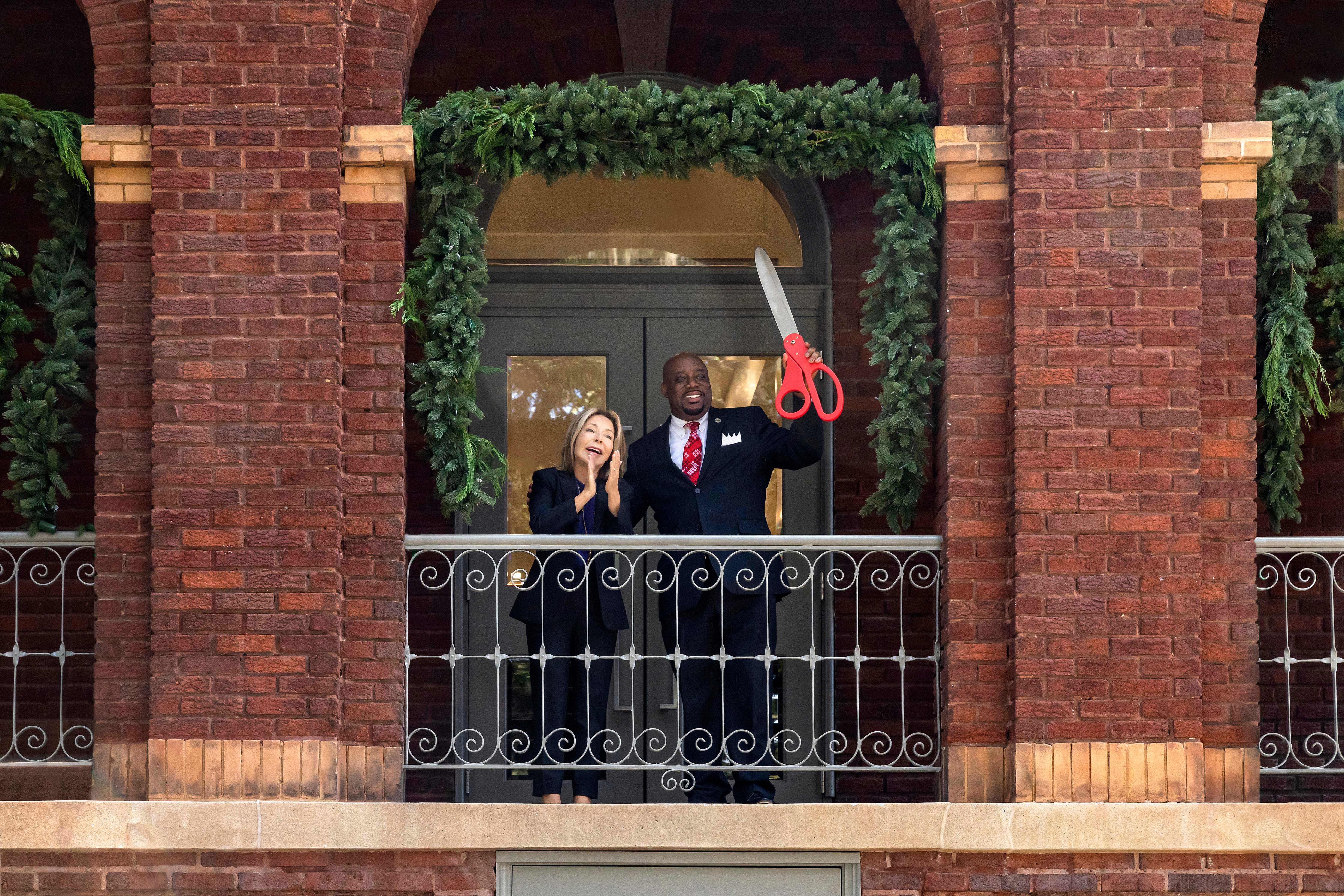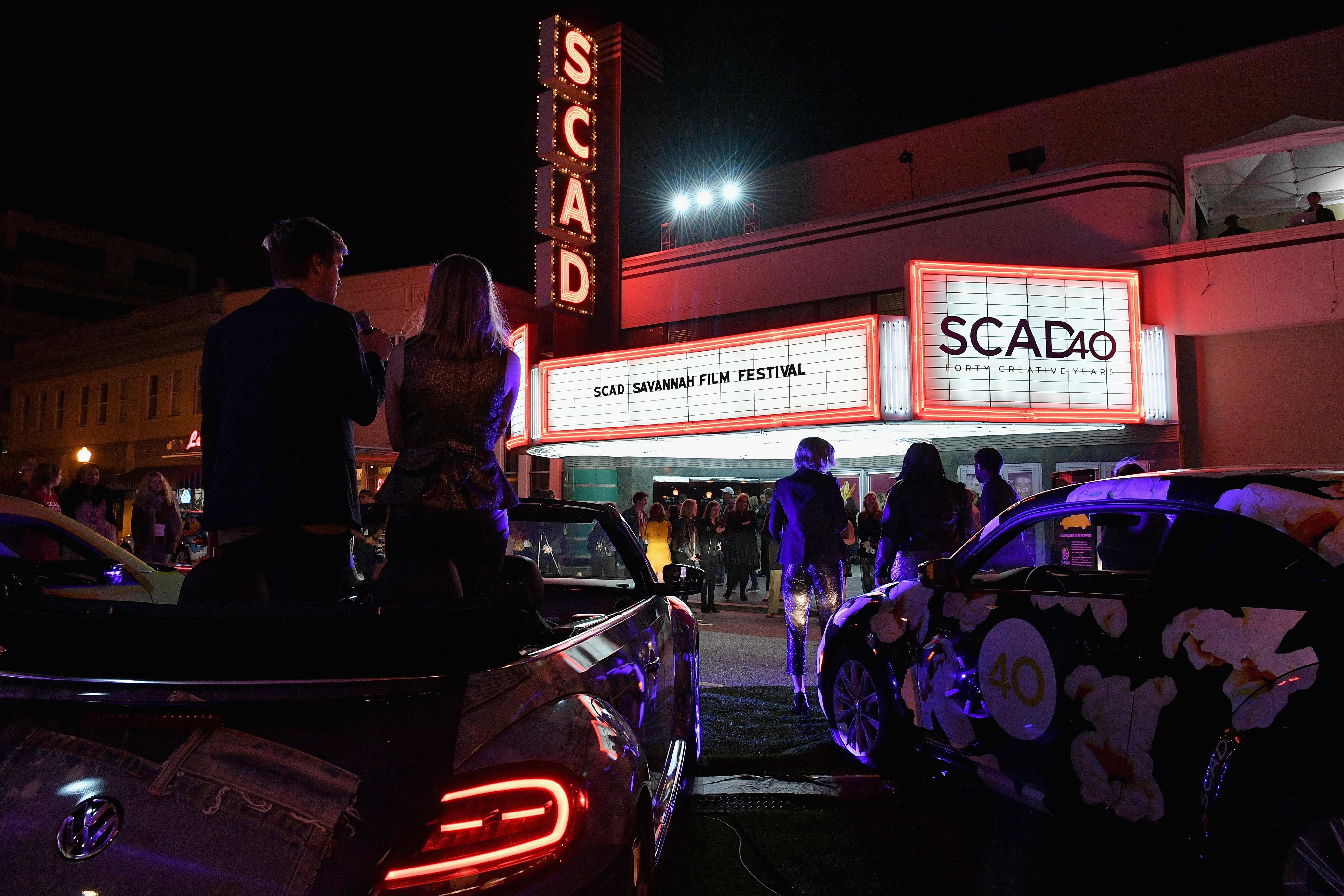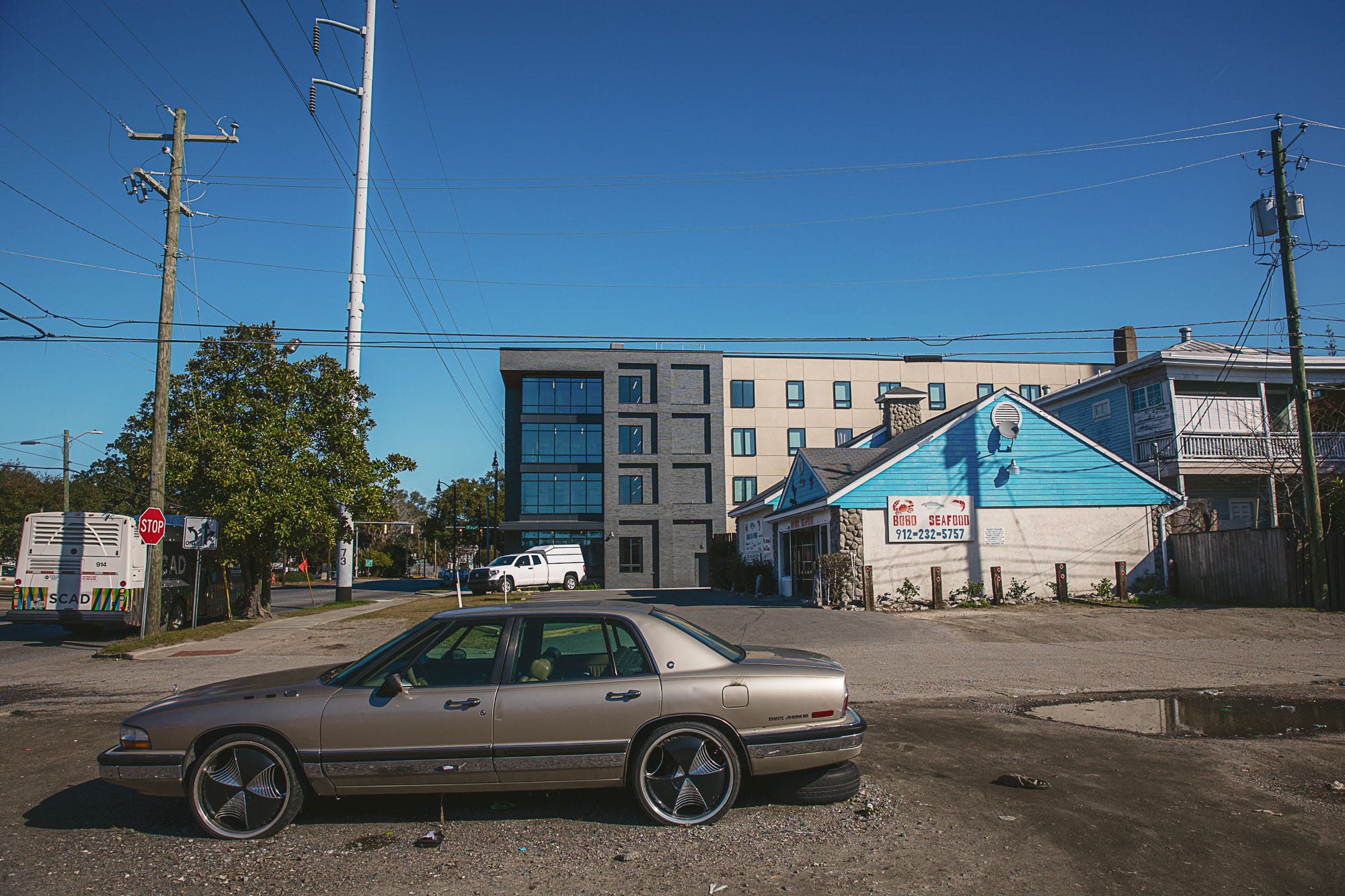Savannah College of Art and Design helped push Savannah growth
This story is part of the Art of Gentrification, an investigative series looking at how the Savannah College of Art and Design has impacted the city’s downtown and surrounding neighborhoods.
Protected from the pelting rain in red and blue ponchos, four figures stood on the northeast corner of Fahm and Turner streets and threw verbal rocks at Turner House, the five-story co-ed residential complex for first-year Savannah College of Art and Design students.
“Black people used to live here!”
Keiajah Brooks, an activist and merchandise designer, bellowed into her megaphone as she led the protest. Across the street, parents and students hauled mini fridges, futons, luggage and desk lamps down the sidewalk and into the courtyard. The start of the Fall 2021 quarter was just days away.
Richard Burkhart/Savannah Morning News
The land where Turner House opened in 2008 had historically been used for commercial and industrial buildings to support the Central of Georgia railroad, according to archival maps of the city. But historically Black neighborhoods north, west and south of the dorm have been emptied of their long-time residents over the past 60 years as public infrastructure in the form of highways and bridges, and tourism- and university-related businesses moved into town.
Previous SCAD development reporting: SCAD issues $159M bond to build 17-story dorm on River Street, renovate Chatham Apartments
The rain failed to quell the protestors’ anger with Savannah’s biggest university. Brooks screamed at a student who filmed the protest on his phone. She traded barbs with police officers who fined her for using a megaphone without a permit ($800 for the fine; $0 for the permit). She questioned the intent of white people who walked up to join her four-day protest.
She wanted the freshmen — but more importantly, their parents — to understand the realities of the place where they would be living – the realities not found in course catalogs and brochures or mentioned by the guides in the white trolley tour buses that picked up passengers in the lot to her west. And she wanted them to know what she thought of their school in the hopes it would spur them to action. Money talks, Brooks said, and the checks SCAD parents cut are the only way to get school leadership to listen.
First City Progress: Group calls on SCAD, city, county to enter payment-in-lieu-of-taxes program
“They sell this kind of art fantasy, like ghost tours and history, and they forget to mention to people that there’s Black people who’ve lived here throughout history,” Brooks said two days before the protest, when she walked around West Savannah handing out fliers and inviting locals to her cause.
“I honestly don’t think 90{6d6906d986cb38e604952ede6d65f3d49470e23f1a526661621333fa74363c48} of SCAD students come here knowing what’s going on or knowing the history of Savannah,” she added. “And knowing that there are people who have never left here since slavery.”
They sell this kind of art fantasy, like ghost tours and history, and they forget to mention to people that there’s Black people who’ve lived here throughout history.
Brooks’ sentiments are rooted in the displacement of lower- and middle-income Black families from the downtown neighborhoods to the city’s edges. In the past three decades, that displacement has been fueled largely by two forces: tourism and SCAD’s ever-growing footprint.
The burden of this change is not only SCAD’s to bear. Dozens of factors influence gentrification, of which displacement is a symptom. Real estate investors, infrastructure improvements, a COVID-driven migration of wealthy professionals from across the country into the city, and an energetic tourism industry have all contributed to the city’s housing affordability crisis.
But residents have seen SCAD’s presence growing for decades. The past few years have seen its presence inching further south into second- and third-ring neighborhoods, such as Bingville and Feiler Park, home to hundreds of low- and middle-income families.
Richard Burkhart/Savannah Morning News
“You revitalize [Savannah] for people to come in who don’t have the connections here,” said fellow protestor Amir Jamal Touré, a Savannah native who advocates for human rights with Geechee Kunda, a living history museum in Riceboro.
‘I’m in prison’: Disabled Savannahians struggle to find affordable, accessible housing
Touré said SCAD uses Savannah’s tourism and vibrancy to grow and recruit students, but that the university fails to acknowledge who built the city. As he protested alongside Brooks that August day, the Geechee man wielded a sign that said, “You are displacing us.”
“[African Americans] built up a foundation for people to come here and to enjoy Savannah, and that foundation is based on the people that you are displacing,” Touré said.
Brooks, Touré and the 912 Liberation Crew gathered on that day, fueled by a rumor.
All believed SCAD was angling to purchase the nearby 1940s-era public housing complex Yamacraw Village, slated for demolition in the coming months. The rumor seemingly began after a SCAD student submitted an urban design proposal for the area in 2019, dubbing their concept “The Y District.” The design was for a competition with the American Institute of Architects and was not intended to serve as a guidepost for the property’s redevelopment, according to a 2021 article from WTOC. Whether the housing complex will be re-imagined, rebuilt, or the land sold for development — leaving the residents scattered throughout the city — has yet to be announced.
[African Americans] built up a foundation for people to come here and to enjoy Savannah, and that foundation is based on the people that you are displacing.
SCAD, however, has been clear on this issue. On Feb. 2, university spokesperson J.J. Maxwell issued the following statement to the Savannah Morning News: “According to SCAD, the university does not have any interest or intention of purchasing or developing the historic Yamacraw property.”
Previous reporting: Local group files appeal to halt Housing Authority’s demolition of Yamacraw, Kayton Homes
Savannah Mayor Van Johnson said he disproves rumors and lies about the university’s plans that come across his desk “on a daily basis.”
But, that doesn’t mean SCAD has stopped – or will stop – growing.

SCAD/Colin Douglas Gray
The Tipping Point
Since opening in 1979 in a restored National Guard Armory building at 340 Bull St., now called Poetter Hall, the art college has expanded to more than 90 buildings across three campuses in Savannah, Atlanta, and Lacoste, France; 15,500 students and nearly 4,000 employees, according to public tax documents.
In Savannah alone, SCAD owns 59 parcels within the boundaries of the Historic Landmark District and has branched holdings into primarily residential neighborhoods such as Starland and now Bingville.
Through historic preservation, SCAD has revitalized dozens of blighted properties in the city, building upon the dream of the seven ladies who in 1955 founded the Historic Savannah Foundation, which established one of the nation’s first revolving loan funds and advocated for tax breaks for folks restoring historic homes and buildings in the distressed downtown neighborhoods.
Recent HSF news: Historic Savannah to restore blighted properties to address affordable housing shortage

Photo by Dia Dipasupil/Getty Images for SCAD
Yet, as with many success stories, there comes a tipping point. Savannah may have reached it.
A number of factors have converged to render Savannah a city geared toward tourists and wealthy transplants, not the people who built this city and who’ve kept it running since its founding in 1733. SCAD is not solely responsible. It is one institution of power in the city that’s stoking a crisis of housing and income inequality, which reached a fever pitch over the past few years as rents skyrocketed to record levels and businesses shuttered under the weight of soaring property prices and pandemic pressures.
Previous reporting: SCAD unveils Pulaski House, 22 units aimed at non-student, downtown, low-wage workers
SCAD’s swelling footprint has spurred both new development and redevelopment, helped decrease crime and contributed, by its own estimation, $577 million annually to Savannah’s economy. Annual events such as the SCAD Savannah Film Festival bring thousands of visitors to town, and the university said there are 120 SCAD alum-owned businesses in Savannah contributing to the city’s diverse economy.
Because of its nonprofit and educational status, SCAD also has taken nearly $800 million of property out of local tax revenue and spurred gentrification by purchasing and holding land for future growth, razing distressed properties while restoring others, and building new educational and residential facilities that impact surrounding property values (and taxes). Its historic preservation practices have enticed luxury developments to previously low-income neighborhoods surrounding downtown, transforming the makeup of those neighborhoods into a transient community for students and tourists.
SCAD represents itself as a culture monger in the community and world at-large. It views itself as a revitalizer, bristling at the suggestion that its growth has gentrified the historic district or surrounding neighborhoods, stating that “SCAD has a legacy of successful, positive urban revitalization—as opposed to gentrification.
“According to urban planner Stacey Sutton, ‘Revitalization refers to neighborhood change, improvement, upgrading.’ Gentrification, on the other hand, explains Benjamin Grant, urban design policy director at SPUR Urban Center, is frequently characterized by the displacement of existing residents. SCAD has shown a commitment to improving and invigorating, rather than fundamentally altering or replacing, neighborhoods.”

Richard Burkhart/Savannah Morning News
Savannah Morning News’ own research showed that SCAD is both a revitalizing force that breathed life into a blighted downtown and one of the key instigators of housing unaffordability near critical jobs and transportation corridors. It has been both renewer and gentrifier.
To wrestle with SCAD’s full impact, the Morning News reviewed what was publicly available — IRS filings, municipal bond documents, research studies and the university’s public tour — to separate fact from fiction. In its ongoing effort to search for solutions to Savannah’s affordable housing crisis, Savannah Morning News sought to figure out how SCAD’s seemingly unchecked growth has not only transformed the city but also made it harder for middle- and low-income residents to live within its boundaries.
The university refused every interview request made by the Savannah Morning News for this story, opting instead to send a 16-page “fact sheet” that stated the school “saved Savannah” from ruin. Requests to review the university’s in-house economic studies and growth plans also were rebuffed.
Since August 2021, Savannah Morning News has published more than 40 articles exploring the varied and complicated forces influencing housing affordability in the greater Savannah area, examining the policies that can create homelessness, and assessing how both the public and private sectors can work together to provide housing opportunities for people of all incomes. Together, these stories have resulted in relocation assistance for people displaced from their homes, additional funding for housing programs, and broader community conversations leading toward solutions. The work continues and that’s why some articles fall behind a paywall — so that we can provide the kind of thoughtful, in-depth journalism that enlightens and engages our community.
To continue reading this series, subscribe here $1 for six months.
